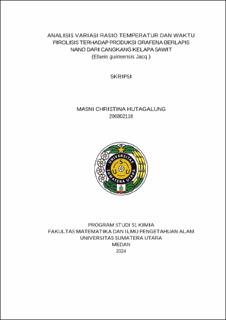| dc.description.abstract | Research on the analysis of the variatios in temperature (T) and time (t) ratio during pyrolysis on the production of graphene nano sheets from palm kernel shells has been conducted. The purpose of this research is to analyze the effect of variations temperature and time on the second pyrolysis and analyze the characteristics of the GNS produced. This research is an experimental laboratory. GNS was synthesized from palm kernel shells raw materials using pyrolysis method, with various temperature and time variations namely (Tpirolysis-I = 350 oC, 400 oC, and 450 oC, tpirolysis-I = 3 hours; Tpirolysis-II = 350, 400, and 450 oC; tpirolysis-II = 1 and 2 hours) then resulting GNS products were characterized using X-Ray Diffraction (XRD), Scanning Electron Microscopy Energy Dispersive X-Ray (SEM- EDX), Fourier Transform Infrared (FTIR), and Multimeter. The research showed that the optimum pyrolysis conditions to produce GNS with the best crystallinity, morphology and electrical conductivity form palm kernel shells was the treatment in the third variation (Tpirolysis-I = 350 oC, tpirolysis-I = 3 hours; Tpirolysis-II = 400 oC, tpirolysis-II = 1 hour). XRD data of GNS showed a wide and weak peak at C (002) (2ϴ = 24,25o) and C (100) (2ϴ = 44,6o) indicating that GNS has been successfully produced with amorphous crystallinity. This XRD data is also supported by data from SEM-EDX, FTIR, and DHL. SEM-EDX data shows thin sheets stacked on GNS with small pores and dominated by carbon atoms (C) by 89.50 % and has an aromatic C C karbon structure at a wavelength of 1572,39 cm-1 (FTIR data), and is capable of conducting electric current. | en_US |


